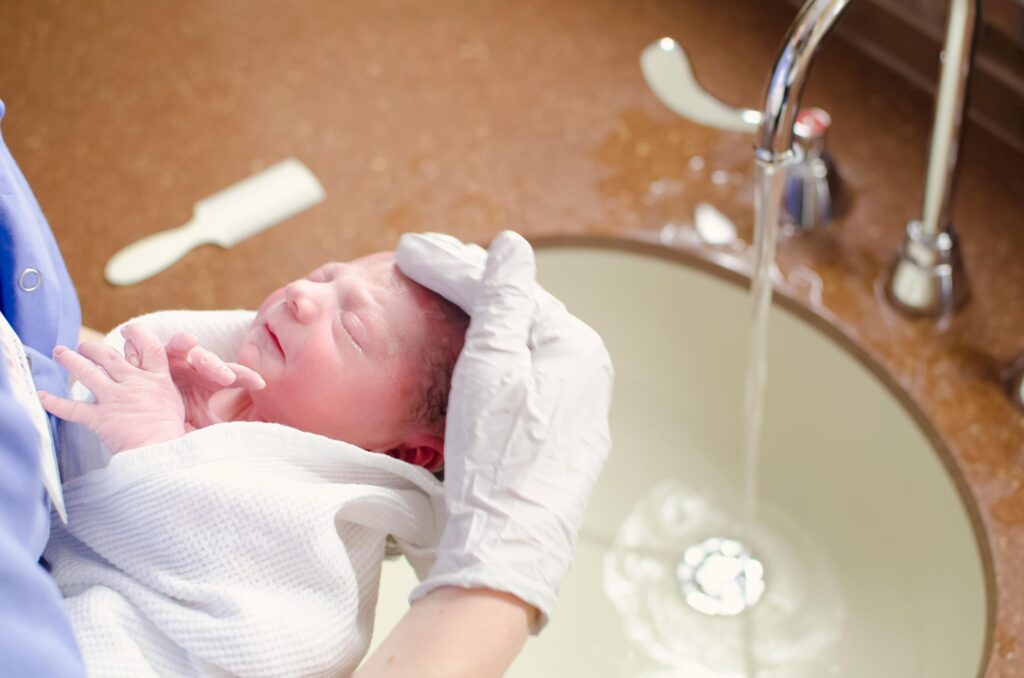As a mother of five and a midwife with over two decades of experience, I’ve witnessed firsthand the mix of joy and uncertainty that comes with welcoming a tiny new person into your home. One question that consistently comes up with new parents is about newborn bathing frequency – how often should that precious little bundle actually get a bath? Let me guide you through this delightful (and sometimes slippery!) aspect of newborn care with both professional expertise and the hard-earned wisdom that comes from bathing five babies of my own.
Understanding Your Newborn’s Bathing Needs
When my first baby arrived nearly 25 years ago, I thought I needed to bathe him daily. After all, that’s what I did for myself! It wasn’t until I was deeper into my midwifery training that I discovered newborns simply don’t need daily baths – and in fact, too much bathing can actually do more harm than good for their delicate skin.
The Science Behind Newborn Skin
Your newborn’s skin is a marvel of nature – thin, sensitive, and still developing its important protective functions. According to the American Academy of Pediatrics, newborn skin is up to 30% thinner than adult skin and loses moisture more quickly. This delicate barrier is easily disrupted by frequent bathing and harsh products.
When I explain newborn bathing frequency to new parents in my midwifery practice, I often share what happened with my third baby. She developed dry, flaky patches after I bathed her every other day in the first week. When I reduced her baths to just twice weekly, her skin transformed back to that perfect baby softness we all adore.
Benefits of Appropriate Bathing Schedules
Finding the right newborn bathing frequency isn’t just about preventing dry skin – it actually supports your baby’s overall health and development:
- Preserves natural skin oils that protect against irritation and infection
- Maintains the skin’s delicate pH balance
- Helps regulate body temperature more efficiently
- Reduces exposure to potential irritants in bath products
- Creates a more enjoyable, stress-free experience for both baby and parents
One mother in my practice described it perfectly: “When we stopped trying to bathe our daughter daily, bath time became a special bonding ritual rather than a stressful chore that ended in tears – both hers and mine!”
How Often Should You Bathe a Newborn? The Expert Recommendations
After working with hundreds of families and raising five children of my own, I can confidently say that the ideal newborn bathing frequency is typically 2-3 times per week during the first month of life. This allows for cleanliness while protecting their sensitive skin barrier.
The First Week: Special Considerations
During your baby’s first week, even less bathing is appropriate. With my fifth baby, I waited a full three days after birth before giving her first gentle sponge bath, focusing only on the essential areas. This allowed her skin to adjust to life outside the womb while still being protected by the natural vernix – that wonderful white, cheese-like substance that coats newborns and provides remarkable skin protection.
For the vernix, I always tell my midwifery clients: “Nature designed that perfect first moisturizer – let it absorb naturally rather than washing it away!”
Signs Your Bathing Routine Needs Adjustment
While 2-3 times weekly works well for most babies, your unique little one may have different needs. Watch for these indicators that your newborn bathing frequency might need adjustment:
- Dry, flaky, or red patches on the skin (might need fewer baths)
- Persistent milk neck folds or diaper area odor (might need more spot cleaning)
- Excessive crying or stress during bath time (might need to modify your technique)
- Heat rash or tiny bumps (might need fewer baths or cooler water)
When my second daughter developed persistent redness in her neck folds despite infrequent full baths, I realized she needed daily gentle cleansing of just that area with warm water and a soft cloth – no soap. This personalized approach is what I emphasize in my practice: observe your baby and adapt accordingly.
Creating an Effective Bathing Schedule
Establishing the right newborn bathing frequency involves more than just counting days between baths. Here’s how to develop a bathing rhythm that works for both you and your little one.
Between-Bath Cleansing Tips
I vividly remember my grandmother watching me prepare for my firstborn’s third bath of the week and gently saying, “You know, dear, babies don’t need a full dunk to stay clean.” She was absolutely right! Between baths, these simple daily cleansing practices keep your baby fresh:
- Gently clean the face with a soft, damp washcloth (no soap needed)
- Wipe neck folds, armpits, and groin areas during diaper changes
- Clean the diaper area thoroughly at each change
- Wipe spit-up promptly from the chin and neck area
With my twins, I kept a small basket of clean, dampened washcloths near their changing area for quick spot cleaning throughout the day. This simple system kept them comfortable between their twice-weekly baths.
Best Times for Bathing Your Newborn
The timing of your baby’s bath can significantly impact their experience and yours. Through years of midwifery practice, I’ve observed that most babies respond best to these timing considerations:
- Choose a time when your baby is alert but not hungry or overtired
- Avoid bathing immediately after feeding (can increase risk of spit-up)
- Consider establishing a consistent pre-bedtime bath routine once your baby is a few weeks old
- Allow plenty of time without rushing (stress transfers easily to your baby)
With my fourth child, we discovered that morning baths worked best, contrary to popular advice about evening bathing. He was more alert and engaged in the mornings, making bath time a delightful experience rather than a bedtime battle. This personalized timing made all the difference in establishing positive bath associations.
Practical Bathing Techniques for Newborns
Now that we’ve established appropriate newborn bathing frequency, let’s talk about how to make each bath as safe and enjoyable as possible. After bathing five babies of my own and guiding hundreds of new parents, I’ve collected some tried-and-true techniques.
Sponge Baths vs. Immersion Baths
Until your baby’s umbilical cord stump falls off (typically 1-2 weeks after birth), sponge baths are the safest option. I remember the gentle sponge bath ritual I developed with my first baby – wrapping him in a warm towel and exposing only the area I was washing at any given moment to keep him warm and secure.
For sponge baths:
- Gather all supplies before starting
- Keep the room warm (around 75°F/24°C)
- Place baby on a soft, flat surface or your lap
- Use a warm, damp washcloth to gently cleanse one area at a time
- Pat dry immediately after cleaning each section
Once the cord stump has fallen off and healed, you can transition to immersion baths in a baby tub with 2-3 inches of warm water. The World Health Organization recommends waiting at least 24 hours after the cord falls off before the first immersion bath to prevent infection.
Making Bath Time Enjoyable and Stress-Free
The emotional experience of bath time is just as important as the physical cleansing. Creating positive associations with bathing will serve your child well throughout their life.
With my third baby, who initially feared water, I discovered the power of narration. Simply explaining what I was doing in a cheerful, sing-song voice transformed her bath time experience from fearful to joyful within just a few bathing sessions.
Try these approaches to create positive bath experiences:
- Maintain eye contact and talk or sing throughout the bath
- Use gentle, confident movements
- Honor your baby’s preferences (some enjoy hair washing first, others last)
- Have warm towels ready for after the bath
- End with a gentle massage using appropriate baby moisturizer
Special Bathing Considerations for Different Babies
Every baby is unique, and their newborn bathing frequency and techniques may need adjustment based on specific needs or conditions.
Premature Babies and Special Skin Conditions
During my midwifery career, I’ve worked with many families of premature infants and babies with skin conditions like eczema or extremely sensitive skin. These little ones typically benefit from even less frequent bathing – often just once weekly – with extremely gentle cleansers specifically formulated for sensitive skin.
For my nephew who was born six weeks early, my sister found that cotton wool and warm water for cleansing, with full baths just once weekly, was the perfect balance for his delicate skin. His pediatric dermatologist confirmed this minimalist approach was ideal for his developing skin barrier.
Cultural Bathing Traditions
Many cultures have beautiful, meaningful bathing rituals for newborns that may influence newborn bathing frequency. In my diverse midwifery practice, I’ve learned to honor these traditions while ensuring they support baby’s health and comfort.
One memorable mother from my practice incorporated her Filipino heritage by adding gentle guava leaf tea to her baby’s bathwater twice weekly – a traditional practice believed to have healing properties. We worked together to ensure this meaningful cultural practice was implemented safely alongside evidence-based bathing frequency recommendations.
Products and Water Temperature: Getting It Just Right
The products you use and the temperature of the water play crucial roles in successful bathing experiences.
Choosing Gentle, Appropriate Products
With my first baby, I used whatever adorable, sweet-smelling baby products caught my eye at the store. By my fifth baby, I’d learned the wisdom of “less is more” when it comes to newborn skincare.
For most newborns, plain warm water is sufficient for the first few weeks. When you do introduce products, select those that are:
- Fragrance-free
- Designed specifically for baby’s sensitive skin
- Free of parabens, phthalates, and harsh chemicals
- pH-balanced for newborn skin
- Applied sparingly, especially in the early weeks
One mother in my practice described her revelation perfectly: “I realized my baby doesn’t need to smell like a flower garden – she already has that perfect baby smell that I love so much!”
Perfect Water Temperature and Safety
Finding the ideal water temperature is essential for both comfort and safety. For all five of my children, I used the traditional “elbow test” – dipping my elbow into the bathwater to ensure it felt comfortably warm but not hot (around 100°F/38°C).
Modern parents might prefer using a bath thermometer for precision, but the principle remains the same: water that’s too hot risks burns, while water that’s too cool can lead to chilling, stress, and a negative bathing experience.
Adjusting Bath Frequency as Your Baby Grows
As your baby grows and becomes more active, you’ll likely adjust their newborn bathing frequency. By around 2-3 months, many babies benefit from slightly more frequent baths, especially once they begin drooling more and becoming more physically active.
With my own children, I typically increased to 3-4 times weekly around the 3-month mark, as they began exploring more and generally getting messier. By 6 months, with the introduction of solid foods (and the inevitable mashed banana in the hair!), near-daily baths often become practical.
Remember that even as bathing becomes more frequent, gentle products and careful attention to skin hydration remain important throughout the first year.
Final Thoughts: Trust Your Instincts While Following Guidelines
After five babies of my own and guiding thousands of families through their early parenting journey, my most heartfelt advice about newborn bathing frequency is this: use the 2-3 times weekly guideline as your starting point, but ultimately trust your observations and instincts about your unique baby.
Your baby’s skin, your family’s lifestyle, your cultural practices, and even your climate will all influence the perfect bathing routine for your family. The connection and confidence you build during these tender care moments matter far more than adhering to a rigid schedule.
I still cherish the memories of those precious bath times with each of my babies – the way their tiny fingers gripped mine, their expressions of wonder at the sensation of water, and the sweet cuddles afterward wrapped in a warm towel. Beyond the practical aspects of cleanliness, these moments build the foundation of trust and attachment that nurtures your baby’s sense of security in the world.
So as you navigate the question of how often to bathe your precious newborn, remember that your loving attention to their cues and needs is the true essence of good care – everything else is just water and soap.



